Turkish Airlines Flight 1951
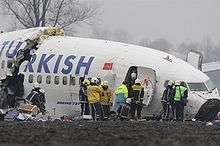 The Turkish Airlines Boeing 737-8F2, registration TC-JGE, just after the crash near Schiphol Airport. | |
| Accident summary | |
|---|---|
| Date | 25 February 2009 |
| Summary | Stall while landing at 400ft because of faulty Radio altimeter and Pilot Error[1][2][3][4][5] |
| Site |
North of the Polderbaan runway (18R/36L), near Amsterdam Airport Schiphol 52°22′34″N 4°42′50″E / 52.37611°N 4.71389°ECoordinates: 52°22′34″N 4°42′50″E / 52.37611°N 4.71389°E |
| Passengers | 128 |
| Crew | 7 |
| Fatalities | 9 |
| Injuries (non-fatal) | 117 (including 11 serious) |
| Survivors | 126 |
| Aircraft type | Boeing 737-8F2 |
| Aircraft name | Tekirdağ |
| Operator | Turkish Airlines |
| Registration | TC-JGE |
| Flight origin | Istanbul Atatürk Airport, Istanbul, Turkey |
| Destination | Amsterdam Airport Schiphol, Amsterdam, Netherlands |
Turkish Airlines Flight 1951 (also known as the Poldercrash) was a passenger flight that crashed during landing at the Amsterdam Schiphol Airport, Netherlands, on 25 February 2009, resulting in the death of nine passengers and crew including all three pilots.
The aircraft, a Turkish Airlines Boeing 737-800, crashed into a field approximately 1.5 kilometres (0.93 mi) north of the Polderbaan runway, (18R), prior to crossing the A9 motorway inbound, at 9:31 UTC (10:31 CET), having flown from Istanbul, Turkey. The aircraft broke into three pieces on impact. The wreckage did not catch fire.[6][7][8]
The crash was caused primarily by the aircraft's automated reaction which was triggered by a faulty radio altimeter. This caused the autothrottle to decrease the engine power to idle during approach. The crew noticed this too late to take appropriate action to increase the thrust and recover the aircraft before it stalled and crashed.[9] Boeing has since issued a bulletin to remind pilots of all 737 series and BBJ aircraft of the importance of monitoring airspeed and altitude, advising against the use of autopilot or autothrottle while landing in cases of radio altimeter discrepancies.[10]
Background
Aircraft
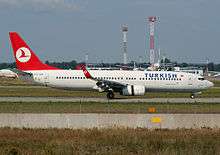
The aircraft, built in 2002, was a Next Generation Boeing 737-800 series model 8F2[11] with registration TC-JGE, named "Tekirdağ".[12][13] The model −8F2 denotes the configuration of the 737-800 built for use by Turkish Airlines. They had 51 aircraft of this model in service at the time of the crash.[14]
Flight
There were 128 passengers and seven crew members on board.[12][15][16] The plane was under the command of Instructor Captain Hasan Tahsin Arısan,[17] one of the airline's most experienced senior pilots. A former Turkish Air Force fleet commander, Captain Arısan had been working for Turkish Airlines since 1996. He had over 5,000 hours of flight time on the F-4E Phantom II.[18] The other flight deck crew members were Olgay Özgür, was the safety pilot of the flight, and he was a graduate of a flight school in Ankara, and flew the MD 80 for World Focus Airlines before joining Turkish Airlines and passing the 737 type rating, he was sitting in the cockpit's center jump seat, and Murat Sezer, co-pilot under line training, flying as co-pilot. The cabin crew consisted of Figen Eren, Perihan Özden, Ulvi Murat Eskin, and Yasemin Vural.[17]
Landing and damage
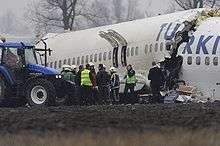
| Wikinews has related news: Airplane crashes at Schiphol Airport; 9 killed |
The plane was cleared for an approach on runway 18R (also known as the Polderbaan runway) but came down short of the runway threshold, sliding through the wet clay of a plowed field.
The aircraft suffered significant damage. Although the fuselage broke into three pieces, it did not catch fire. Both engines separated and came to rest 100 metres (300 ft) from the fuselage.[18]
Aftermath
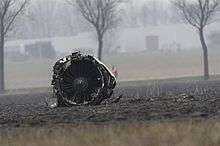
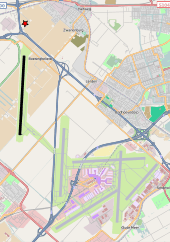
While several survivors and witnesses indicated that it took rescuers 20 to 30 minutes to arrive at the site after the crash,[19][20] others have stated that the rescuers arrived quickly at the scene.[19][21][22] About 60 ambulances arrived along with at least three LifeLiner helicopters (air ambulances, Eurocopter EC135), and a fleet of fire engines.[23] An unconfirmed report by De Telegraaf states that the firefighters were at first given the wrong location for the crash site, delaying their arrival.[24] Lanes of the A4 and A9 motorways were closed to all traffic to allow emergency services to quickly reach the site of the crash.
The bodies of three cockpit crew members were the last to be removed from the plane, at around 20:00 that evening, because the cockpit had to be examined before it could be cut open to get to these crew members.[25] Also, some of the survivors say that at least one of the pilots was alive after the crash.[26] The relatives of the passengers on the flight were sent to Amsterdam by Turkish Airlines shortly after.[27]
All flights in and out of Schiphol Airport were suspended, according to an airport spokeswoman. Several planes were diverted to Rotterdam The Hague Airport as well as to Brussels Airport. At about 11:15 UTC, it was reported that the Kaagbaan runway (06/24) had been re-opened to air traffic, followed by the Buitenveldertbaan runway (09/27).[28]
Turkish Airlines continues to use Flight 1951 on its Istanbul (Atatürk) to Amsterdam route, using an Airbus A330.[29]
Investigation

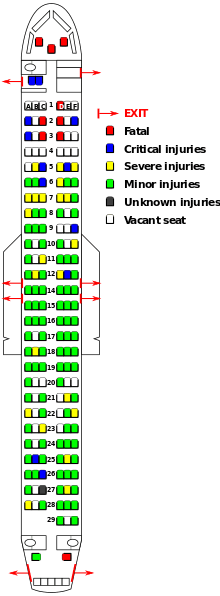
The investigation was led by the Dutch Safety Board (DSB, Dutch: Onderzoeksraad voor Veiligheid or OVV), and assisted by an expert team from Turkish Airlines and a representative team of the American NTSB, accompanied by advisors from Boeing and the FAA,[30][31] Turkish Directorate General of Civil Aviation (SHGM), the operator, the UK Air Accidents Investigation Branch, and the French Bureau d'Enquêtes et d'Analyses pour la sécurité de l'Aviation Civile (BEA).[10][32] The cockpit voice recorder and the flight data recorder were recovered quickly after the crash, after which they were transported to Paris to read out the data.[33] The Dutch public prosecution initially asked the DSB to hand over the black boxes, but the DSB refused to do so. It stated that there was no indication of homicide, manslaughter, hijacking or terrorism, which would warrant an investigation by the prosecution.[34][35]
While on final approach for landing, the aircraft was about 2,000 ft (610 m) above ground, when the left-hand (captain's) radio altimeter suddenly changed from 1,950 feet (590 m) to read −8 feet (−2.4 m) altitude, although the right-hand (co-pilot's) radio altimeter functioned correctly.[9] The voice recording showed that the crew was given an audible warning signal ("TOO LOW!, GEAR!") that indicated that the aircraft's landing gear should be down, as the aircraft was, according to the radio altimeter, flying too low.[9] Later, the safety board's preliminary report modified this analysis, indicating that the flight data recorder history of the captain's radio altimeter showed 8191 feet (the maximum possible recorded) until the aircraft descended through 1950, then suddenly showed negative 8 feet.[36]
The throttles were pulled back to idle thrust to slow the aircraft to descend and acquire the glideslope, but the autothrottle unexpectedly reverted to "retard" mode, which is designed to automatically decrease thrust shortly before touching down on the runway at 27 feet (8.2 m) above runway height.[37] At 144 kt, the pilots manually increased thrust to sustain that speed,[36] but the autothrottle immediately returned the thrust lever to idle power because the first officer did not hold the throttle lever in position. The throttles remained at idle for about 100 seconds while the aircraft slowed to 83 knots (154 km/h), 40 knots (74 km/h) below reference speed as the aircraft descended below the required height to stay on the glideslope.[38] The stick-shaker activated at about 150 metres (490 ft) above the ground, indicating an imminent stall, the autothrottle advanced, and the captain attempted to apply full power.[38] The engines responded, but there was not enough altitude or forward airspeed to recover, and the aircraft hit the ground tail-first at 95 knots (176 km/h).[38]
The data from the flight recorder also showed that the same altimeter problem had happened twice during the previous eight landings but that on both occasions the crew had taken the correct action by disengaging the autothrottle and manually increasing the thrust. Investigations are under way to determine why more action had not been taken after the altimeter problem was detected.[39] In response to the preliminary conclusions, Boeing issued a bulletin, Multi-Operator Message (MOM) 09-0063-01B, to remind pilots of all 737 series and Boeing Business Jet (BBJ) aircraft of the importance of monitoring airspeed and altitude (the "primary flight instruments"), advising against the use of autopilot or autothrottle while landing in cases of radio altimeter discrepancies.[10] Following the release of the preliminary report, Dutch and international press concluded that pilot inattention caused the accident,[40][41][42][43] though several Turkish news publications still emphasized other possible causes.[44][45]
On 9 March 2009, the recovery of the wreckage started. All parts of the plane were moved to an East Schiphol hangar[46][47] for reconstruction.
It was reported that the first officer survived the accident but rescuers were unable to reach him via the cockpit door due to security measures introduced in the wake of the September 11, 2001 attacks. The rescuers eventually cut their way into the cockpit through the roof, by which time the first officer had died.[48]
On 6 May 2010 the final report was released.[49] Turkish Airlines disputes crash inquiry findings on stall recovery.[50]
Passengers
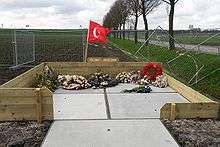
There were nine fatalities and a total of 117 injuries, 11 of them serious.[49](p29,178–180) Five of the deceased victims were Turkish citizens, including the pilot, the co-pilot, a trainee pilot and one member of the cabin crew.[51][52][53][54] Four were Americans, of whom three have been identified as Boeing employees stationed in Ankara and working on an Airborne Early Warning and Control (AEW&C) program for the Turkish military.[6][15][47][55][56]
The plane carried 53 passengers from the Netherlands, 51 from Turkey, seven from the United States, three from the United Kingdom, one each from Germany, Bulgaria, and Italy, and one from either Thailand[57][58] or Taiwan.[55][56][59]
Among the passengers were the sisters Jihad and Hajar Alariachi, presenters of the Dutch television programme De Meiden van Halal. Jihad and Hajar were taken to hospital with minor injuries.[60]
In media
The story of the disaster was featured on the tenth season of Canadian TV series Mayday, the episode is entitled "Who's in Control?".[61]
See also
References
- ↑ Toby Sterling (6 May 2010). "Tech problem, pilots caused Turkish Airlines crash". Bloomberg Businessweek. Associated Press.
A common malfunction with Boeing radio altimeters, compounded by several errors by pilots, led to last year's fatal crash by a Turkish Airlines plane as it dropped short of the runway at Amsterdam's airport, according to investigators' final report released Thursday.
- ↑ RNW News and Peter van Beem (4 March 2009). "Faulty altimeter caused airline crash". Radio Netherlands. Archived from the original on 10 March 2009.
- ↑ "Altimeter fault behind Turkish Airlines crash". AFP. 5 March 2009. Archived from the original on 6 July 2011.
- ↑ "Dutch investigators determine cause of Turkish airlines crash". Deutsche Welle. 5 March 2009. Archived from the original on 10 April 2009.
Investigators found that a faulty altimeter caused the plane's autopilot to shut down the engines as it made its approach to land
- ↑ "Faulty altimeter contributed to Turkish Airlines crash: officials". CBC News. 4 March 2009.
According to recorded conversation involving the plane's captain, first officer and an apprentice pilot in the cockpit, the faulty altimeter was noticed but wasn't considered a problem.
- 1 2 "CNN: Turkish plane crashes at Amsterdam airport". 25 February 2009. Retrieved 25 February 2009.
- ↑ "Turkish plane crash in Amsterdam". BBC News. 25 February 2009. Retrieved 25 February 2009.
- ↑ Simon Hradecky. "Accident: Turkish Airlines B738 at Amsterdam on Feb 25th 2009, landed on a field". The Aviation Herald.
- 1 2 3 "Press Statement on first findings, 4 March 2009" (PDF) (in Dutch). Onderzoeksraad voor Veiligheid. 4 March 2009., official translation from "[Press statement on first findings]" (PDF) (in Dutch). Onderzoeksraad voor Veiligheid. 4 March 2009.
- 1 2 3 Frances Fiorino (5 March 2009). "Boeing warns of possible 737 altimeter fault". Aviation Week.
- ↑ "25 FEB 2009 Boeing 737-8F2". Aviation Safety Network. Retrieved 25 February 2009.
- 1 2 "Accident Information Page". Turkish Airlines. Archived from the original on 2 March 2009. Retrieved 26 February 2009.
- ↑ "Aircraft TC-JGE Profile". AirportData.com. Retrieved 26 February 2009.
- ↑ "Fleet Data Turkish Airlines". Turkish Airlines. Archived from the original on 3 March 2009.
- 1 2 Algemeen Nederlands Persbureau (26 February 2009). "Vijf Turken en vier Amerikanen omgekomen bij crash" (in Dutch). TC/Tubantia. Archived from the original on 2 March 2009. Retrieved 26 February 2009.
- ↑ Final report, section 2.4 "History of the flight", p.25
- 1 2 Turkish Airlines names four dead crew members in Amsterdam crash
- 1 2 Caroline Brothers and Sebnem Arsu (25 February 2009). "9 killed as Turkish plane crashes near Amsterdam". Paris: International Herald Tribune.
- 1 2 "Kranten staan uitgebreid stil bij crash" (in Dutch). fok.nl. 26 February 2009.
- ↑ "Kazadan kurtulan yolcular olayı anlattı" (in Turkish). 25 February 2009. Archived from the original on 13 July 2009.
- ↑ "How the Schiphol crash happened". BBC News. 25 February 2009.
Helpers arrived at the scene very quickly and gave first aid on the spot
- ↑ "Turkish Airlines plane crashes near Schiphol – 5th Update". 25 February 2009.
- ↑ Liz Hazelton (26 February 2009). "Nine dead but 126 survive after plane crashes and breaks into three pieces at Amsterdam airport". Daily Mail.
- ↑ "Boeing 737 Crasht Bij Schiphol" (in Dutch). De Telegraaf. 25 February 2009.
- ↑ "Crash B-737-800 Turkish Airlines, Schiphol Amsterdam killing at least 9". Aviation News EU. 25 February 2009.
- ↑ "Ürperten iddia: Pilot yaşıyordu, zamanında yardım edilmediği için hayatını kaybetti". Zaman Newspaper (Turkish). 25 February 2009.
- ↑ "Vliegtuig met familieleden gearriveerd" (in Dutch). nu.nl. 25 February 2009. Retrieved 5 March 2009.
- ↑ "Negen doden bij vliegtuigcrash Schiphol" (in Dutch). Volkskrant. 25 February 2009. Retrieved 5 March 2009.
- ↑ http://www.flightradar24.com/data/flights/tk1951/
- ↑ "Hollanda'da THY uçağı yere çakıldı" (in Turkish). Radikal. 26 February 2009.
- ↑ "NTSB sends team to Amsterdam to assist with 737 aircraft accident investigation" (Press release). National Transportation Safety Board. 25 February 2009.
- ↑ "Onderzoeksraad start onderzoek crash Turkish Airlines op Schiphol" (in Dutch). 25 February 2009.
- ↑ "Het wachten is op de zwarte doos". de Volkskrant. 27 February 2009.
Maar wat de crash nu écht heeft veroorzaakt, zal mogelijk pas blijken als de zwarte doos is uitgelezen in Parijs, bij het Bureau d’Enquêtes et Analyses (BEA).
- ↑ "Van Vollenhoven geeft zwarte dozen niet af" (in Dutch). NRC Handelsblad. 28 February 2009. Retrieved 28 February 2009.
Alleen wanneer er sprake is van „moord, doodslag, gijzeling of terrorisme” is de onderzoeksraad, volgens Van Vollenhoven, verplicht om dat te melden bij het OM. Dat is vooralsnog niet het geval en het OM krijgt de gevraagde gegevens niet, zo maakte Van Vollenhoven duidelijk in het tv-programma Nova
- ↑ "Google translation of NRC Handelsblad story". NRC Handelsblad. 28 February 2009. Retrieved 28 February 2009.
- 1 2 "Preliminary Report: Turkish Airlines Flight 1951" (PDF). The Dutch Safety Board. 28 April 2009. Retrieved 29 April 2009.
- ↑ "Automatic flight – system description: Automatic Flight Approach and Landing". 737 flight crew operations manual. The Boeing Company. 27 September 2004. Section 4.20.14
- 1 2 3 David Kaminski-Morrow (4 March 2009). "Crashed Turkish 737's thrust fell after sudden altimeter step-change". Flight Global.
- ↑ "Faulty altimeter played part in Turkish crash". Reuters. 4 March 2009.
- ↑ "Piloten Turkish Airlines grepen te laat in" (in Dutch). Trouw. 4 March 2009. Archived from the original on 5 March 2009. Retrieved 10 March 2009.
- ↑ "Boeing issues reminder after Netherlands crash". ABC News. 4 March 2009. Retrieved 10 March 2009.
- ↑ Bremner, Charles (5 March 2009). "Turkish Airlines pilots ignored faulty altimeter before Amsterdam crash". London: The Times. Retrieved 10 March 2009.
- ↑ "Schiphol airliner crash blamed on altimeter failure, pilot error". Wikinews. 5 March 2009. Retrieved 10 March 2009.
- ↑ "Dutch explanations on plane crash raise more questions than answers". Today's Zaman. 6 March 2009. Retrieved 10 March 2009.
- ↑ "Oh, the humanity". Sabah. 6 March 2009. Archived from the original on 11 March 2009. Retrieved 10 March 2009.
- ↑ "Dutch remove Turkish plane wreckage: Dutch experts started the work to remove the wreckage of the Turkish plane which crashed in Amsterdam, killing nine". World Bulletin. 9 March 2009.
- 1 2 "Turkish Airlines plane wreckage to be removed – The wreckage will be taken to a hangar in East Schiphol". Radio Netherlands. 9 March 2009.
- ↑ "Schiphol crash pilot's death draws cockpit door scrutiny". Flight Global. Retrieved 23 September 2009.
- 1 2 Pieter van Vollenhoven; et al. (6 May 2010). "Crashed during approach, Boeing 737-800, near Amsterdam Sc hiphol Airport, 25 February 2009" (PDF). The Dutch Safety Board.
- ↑ David Kaminski-Morrow (7 May 2010). "Turkish Airlines disputes crash inquiry findings on stall recovery".
- ↑ "Turkey plane crashes in Amsterdam". BBC News. 25 February 2009. Retrieved 6 March 2009.
- ↑ "Laatste eer aan bemanningsleden Turkish Airlines" (in Dutch). 28 February 2009. Retrieved 28 February 2009.
- ↑ "Nine killed as Turkish plane crashes at Amsterdam – Summary". Earth Times.
- ↑ "Geen onervaren piloot in verongelukt toestel" (in Dutch). Nu.nl, Algemeen Nederlands Persbureau. 26 February 2009. Retrieved 6 March 2009.
- 1 2 "Status of All Four Boeing Employees Confirmed in Amsterdam Accident". Boeing. 28 February 2009.
- 1 2 James Wallace (27 February 2009). "Boeing confirms three employees died on airliner: another hospitalized with serious injuries". Seattle Post-Intelligencer.
- ↑ "Passenger List". Turkish Airlines. Retrieved 27 February 2009.
- ↑ "6 doden en 4 gewonden niet geïndentificeerd" (in Dutch). Trouw. 26 February 2009. Retrieved 26 February 2009.
- ↑ "5 Turks, 4 Americans among dead in Dutch crash". Yahoo. Associated Press. 26 February 2009. Archived from the original on 25 October 2012. Retrieved 26 February 2009.
- ↑ "Meiden van Halal in ramptoestel" (in Dutch). De Telegraaf. 25 February 2009. Retrieved 26 February 2009.
- ↑ "Mayday – Air Disasters – Seasons I to XIII" (PDF). Cineflix. Retrieved 11 January 2014.
External links
| Wikinews has related news: Airplane crashes at Schiphol Airport; 9 killed |
| Wikimedia Commons has media related to Turkish Airlines Flight 1951. |
|
| |
|
|
- Dutch Safety Board
- Final Accident Report (Archive)
- Final Accident Report (Dutch) (Archive) – The Dutch report is the version of record; if there are differences between the English and Dutch versions, the Dutch prevails
- Index of publications: English | Dutch
- Turkish Airlines
- Turkish Airlines Special Issues (official announcements)
- Passenger List
- Accident / Serious Incident Report for Turkish Airlines Flight 1951 on SKYbrary categorised under Human Factors / Loss of Control
- Google Earth flight path
- Google Maps flight path (openATC)
- Flight tracker
- Accident description at the Aviation Safety Network
- The record of last radio call between ATC and the crew. (site in Turkish)
- Radartrack crashed airplane
- Associated Press: Airliner Crashes in Amsterdam on YouTube (video)
- BBC World News: Nine killed in Amsterdam plane crash on YouTube (video)
- "Nine dead, 84 injured in Turkish Airlines plane crash in Amsterdam". Hurriyet Daily News Online. 25 February 2009.